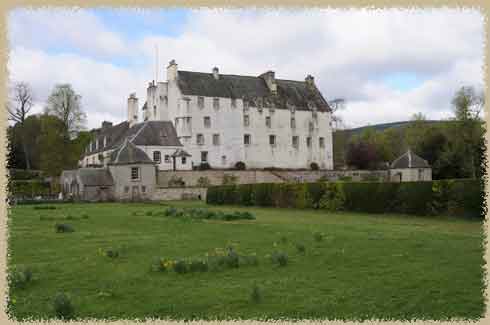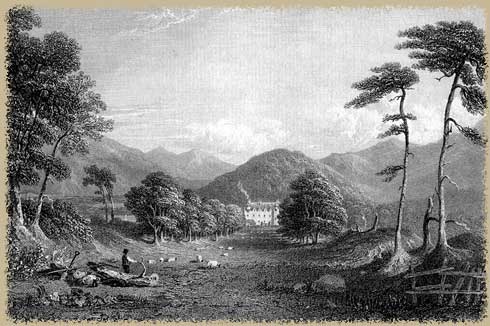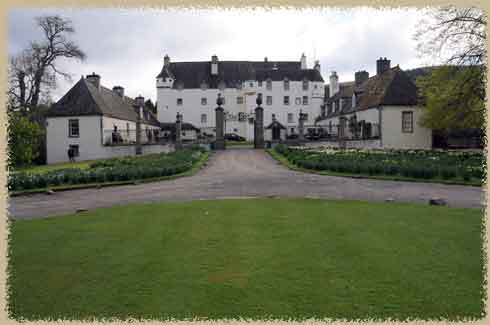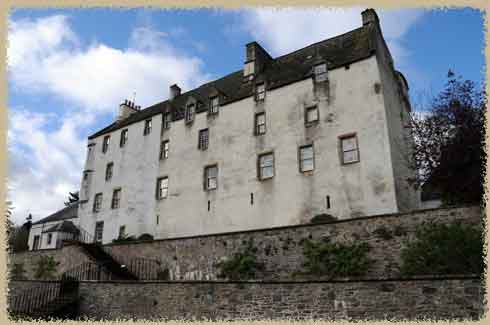Traquair House

a view of the house from the back gardens
Great first stay
Our first night in Scotland was in the "new" wing of this fabulous house -- they have three rooms to let, so it's not really a formal B&B or hotel, but it's comfortable, Helen (the caretaker) is a joy, and there's nothing like staying in the oldest continually occupied house in Scotland as a way to kick off a vacation!
It's a bit laughable that the "new" wing of the hosue dates to the 17th century, really.The house also has a brewery, and one of the oldest beech-hedge mazes on the grounds.
The Original Tower
While the current house is huge, with a massive main block and two newer wings, it doens't seem overwhelming. The earliest part of the castle is the original towerhouse, dating from about 1492, although there are remnants of older foundations dating to the 12th century. The main house is four storys plus an attic.
The house was extended in the 16th century, including a round stair-tower, and the two wings that make up the courtyard date from the late 17th century.

engraving of the house in the Ettrick woods (Wikicommons)
We had a chance to tour the house before it was opened for the day; many of the rooms in the original tower are set up as interesting museum. Many of the items are from the castle itself, and in some rooms original plasterwork and painting have been carefully protected and restored.
The floors through most of the castle have obviously been upgraded and restored (most likely to handle tourists), but you can see the original floor beams in the original tower - one of the museum rooms has a painted ceiling, and the beams are so sway-backed that they look like a hammock.The mural on the wall dates from about 1530, and is one of the oldest in Scotland.
There is also a priest's cell on the top floor, with a hidden reliquary and priest-hole -- the family was Catholic, and it was necessary to be secretive about religious services in Elizabethan England. If they were surprised practicing the 'papist' religion, they needed a place to escape. While it's not possible to actually climb down the rickety staircase, you can peer down into the dark, narrow stairs.
History

Looking from the courtyard to the main house
The earliest building here was probably a Royal Hunting lodge of Alexnader I dating fom 1107. It was probably a wooden building.
By the 13th century, the lands were in the hands of the Douglas family, passing through several other families before it came to the Earls of Buchan in 1478. The Earl, James Stewart, was the king's uncle. His son received the property in 1491, and the current lairds descend from him and the house has remainedin the same family. The original tower house was built by him - a stone structure 3 storys high. It was sizeable tower (9.3m x 7m), and referred to as the 'turris et foratlicicum de Trakware" in 1512 in a royal charter written to approve the expansion of the original castle.
The house has been visited by royalty many times - Scots and English. There are charters on display that account visits from nearly every Scottish king between David I and John Balliol. English kings came as well: Edward I and II; Mary, Queen of Scots and her lover Lord Darnley in 1566, Mary left behind an embroidered quilt (in the collection here, along with the bed she slept in), and the laird of Traquaire even helped her escape Loch Leven in 1568.

an engraving of the house in 1814
Sir John Stewart was created Earl of Traquair in 1638, but the family was brought down by royallist sympathies and the Cromwellians in 1648 (the house history noted that he was begging in the streets of Edinburgh at the end of his life). . He did manage to enlarge the house yet again, and add another story to the north range.
The fourth Earl had big plans, but didn't seem to have followed through with his building additions in the 1690s. The main court was created, and the ornamental wall and fence were added. None of the more drastic plans he had for hte house were ever executed, and the house stands today much as it would have in the late 1700s. The house was completed in 1695 by the architect James Smith of Edinburgh. It hasn't really changed since.
Bonnie Prince Charlie (really, it seriously bad name for him, given his eventual end) came here on his way south in 1745 (historians disagree on whether he actually was here or not). The story is that the famous Bear Gates of the castle were locked behind him when he left, and the 5th Earl swore they would not be opened until a Stewart once again sat on the throne. The house is stil lin Stewart hands (the Maxwell Stewarts), but the gates lie somewhat to the west of the existing house. I was a bit surprised to drive up to the common gate at the courtyard (having heard the story) and have them swing right open, sure I'd done something unforgiveable!
The house declined seriously in the 19th century. The 8th Earl, Charles, was unable to reduce the debt he inherited from his father and much of the estate was sold off. He never married, and no children. The Earldom ended with his death.
The mostly unchanged plan at Traquair is at least partly due to Louise, the sister of the 8th Earl. She lived here until her death in 1875 and refused to allow anything to be changed. When she die,d, the house passed to Henry Maxwell. He hyphenated his name to keep the strong Stewart assoiations of the family.
The Style of the House
The whitewashed walls of the house and the many windows are not particularly 'castle-like', and the hosue as it stands is more of a fortified manor house than a true castle (despite the original tower house incorporated into the building). It has the round bartizans and steep rooflines that will later be a hallmark of the Scottish Baronial style -- it is likely that the house here influenced that movement in architecture.

looking up the terraces to the main house
-- more

